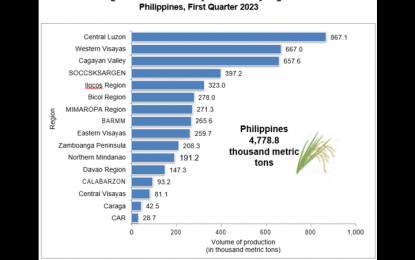
TOP PALAY PRODUCER. Central Luzon remains the country's top palay producer during the first quarter of 2023. Based on the latest data from the Philippine Statistics Authority-Regional Statistical Services Office-Central Luzon (PSA-RSSO III), the region produced 867,084 metric tons of palay, contributing 18.1 percent to the country’s output. (Infographic by PSA)
CITY OF SAN FERNANDO, Pampanga – Rice production in Central Luzon has increased by 12.2 percent during the first quarter of the year, making the region the consistent top producer of palay in the country.
Based on the latest data from the Philippine Statistics Authority-Regional Statistical Services Office-Central Luzon (PSA-RSSO III), the region produced 867,084 metric tons of palay, contributing 18.1 percent to the country’s output.
Western Visayas and Cagayan Valley followed at 14.0 percent and 13.8 percent contributions, respectively while the Cordillera Autonomous Region had the least share at 0.6 percent.
Central Luzon's production volume is higher compared to the 772,855 metric tons during the same period last year.
The double-digit increases in the volume of palay production in the provinces of Nueva Ecija, Pampanga and Zambales contributed to the increase in the region's overall palay production by 9.6 percent.
On the other hand, Aurora, Bataan, Bulacan and Tarlac’s production decreased by 35.9 percent, 2.4 percent, 5.6 percent, and 1.3 percent, respectively.
Data also showed that 99.6 percent or almost all of the palay harvested in the first quarter of 2023 in Central Luzon was from the areas with irrigated ecosystem while only 0.4 percent came from the rainfed ecosystem areas.
Palay harvested under the irrigated ecosystem grew by 12.4 percent to 95,231 metric tons.
Rainfed ecosystem, meanwhile, recorded a 23.9 percent (1,002 metric tons) decrease in the volume of production.
Nueva Ecija is still the top producer of palay in the region with its registered production of 345,547 metric tons for the first quarter of 2023.
This constituted more than one-third or 39.8 percent of the region’s total production.
This was followed by the provinces of Pampanga, Tarlac and Bulacan at 20.0 percent, 19.6 percent, and 11.0 percent, respectively.
The combined production of Aurora, Bataan and Zambales comprised the remaining 9.6 percent of the total palay production in the region.
Crispulo Bautista, regional executive director of the Department of Agriculture-Central Luzon, said the region’s high palay production was due to favorable weather and various government interventions.
These include the distribution of hybrid and inbred seeds as well as fertilizers to the farmers.
Bautista said the distribution of farm machinery and equipment likewise helped boost the farmers’ palay production.
He also cited the government’s Rice Competitiveness Enhancement Fund program which helps farmers attain high yields. (PNA)
